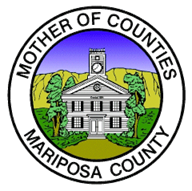Deck
Deck
There are two basic kinds of decks -- those that have a solid surface and those that utilize (usually gapped) deck boards over the structural framing. The upper surface of a solid surface deck and the underside of gapped-board deck are shown in this slide.
During a wildfire, decks can be ignited from a surface fire from below and/or ember attack from above. If ignited, the burning deck will present a long term flame impingement exposure to the side of the house, potentially igniting or otherwise resulting in failure of the siding, and/or breaking the glass of a window or sliding glass door. If the decking and/or siding is very combustible, flames could spread to the eave.
Issues:
- Open frame versus solid surface, membrane deck:
- Most deck boards used in open framed decks are considered combustible (wood, plastic or fiber-plastic composites).
- If exterior rated fire-retardant treated lumber is used, then the deck boards are classified as ignition resistant.
- Most solid surface deck surfaces are noncombustible (concrete, stone, tile, etc.)
- Flame spread, edge of deck to wall
- Enclosure of decks
- horizontal
- vertical
- Need for venting if enclosed
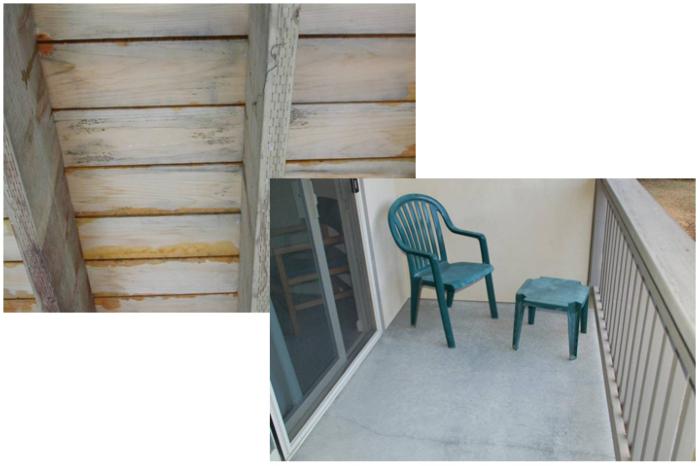
This is an example of a solid surface deck, with an occupied space below (in this case, a garage). The surface is usually noncombustible (light weight concrete or stone). In this case, the wildfire threat would be from an ember exposure to the top of the deck. More critical than the noncombustible surface would be debris that accumulates on the deck, and any combustibles stored or used on the deck (such as firewood and furniture).
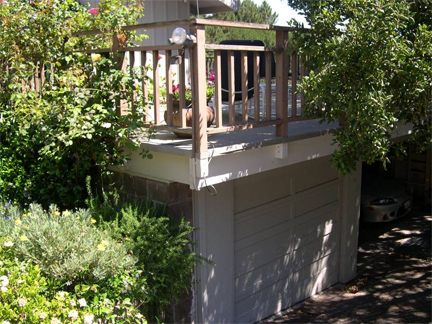
This is an example of a membrane deck with a wood deck. The wood deck boards are attached to 2 x 4 sleepers that rest on a waterproof membrane that is attached to the sheathing. In this example, the wildfire threat would be from embers igniting accumulated debris on deck, accumulated embers igniting the deck boards, and embers igniting deck furniture. Embers and debris would tend to accumulate at a deck-to-wall area, particularly at an interior corner. If the siding is combustible, it could also ignite.
Depending on how far off the ground the deck is, a surface fire burning up the deck could result in a flame impingement exposure to the structural framing members, and the sheathing.
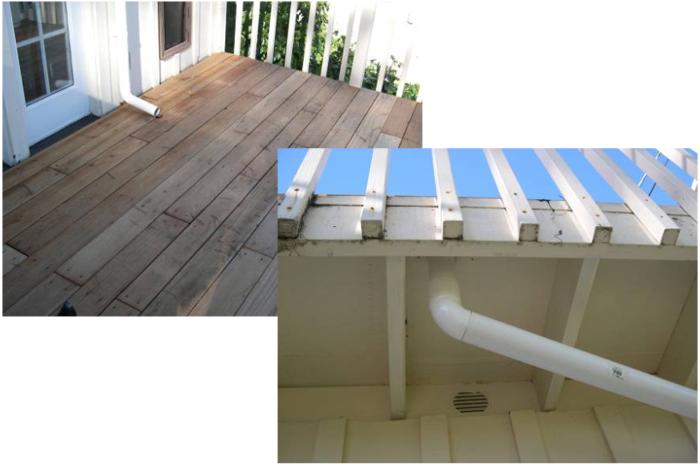
This is an example of a solid surface deck that is enclosed horizontally on the underside. Sometimes enclosed solid surface decks incorporate vents on the underside to allow for some drying should the top surface develop a leak. Depending on the size and location of the leak, venting may or may not be adequate to dry out the space.
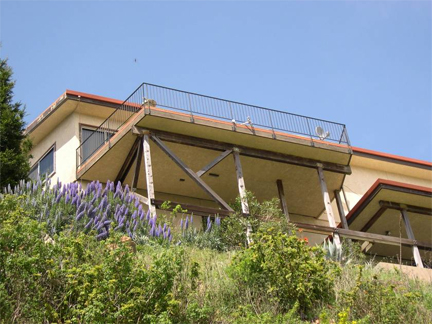
Although some wildfire guides suggest that decks be enclosed, it doesn't always make sense to do this. If your defensible space requirements have been met, and you aren't storing combustible materials under your deck, the benefits of enclosing your deck are minimal, and moisture-related degradation issues become more of a problem.
There are two ways that decks can be enclosed: 1) enclose 'vertically' using a siding product. The siding would be attached to a framing system integral to the vertical support columns, and 2) enclose horizontally , again with a panelized siding product. The siding product would be attached to the bottom of the horizontal support joists.
In a deck consists of gapped deck boards, either of these enclosure methods would result in water moving into the enclosed areas. Some drainage or ventilation system would have to be incorporated into the design, or fungal decay would soon be a problem. The 'vertically' enclosed deck, shown in this slide, has incorporated vents into the design (shown with arrows).
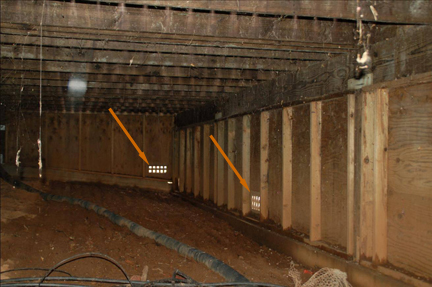
The lattice fencing used as a vertical enclosure on this deck, plus the vegetation, would be readily ignitable during a wildfire and would not be part a good fire safe design.
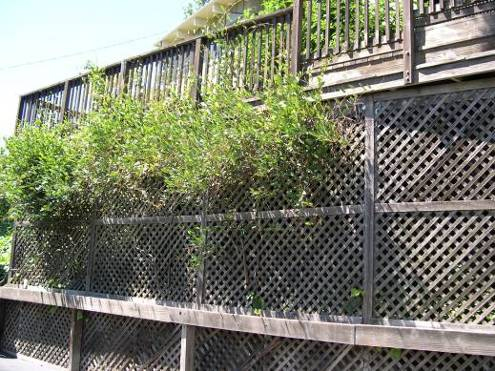
This chain link fence enclosure was probably installed to keep rodents, and maybe kids, from getting under the deck and into the crawl space. This fence still allows vegetative debris to accumulate and makes it more inconvenient to remove it. The deck height is high enough to allow for storage of materials, some combustible.
Decks that are located close to the ground increase the difficulty of removing debris.
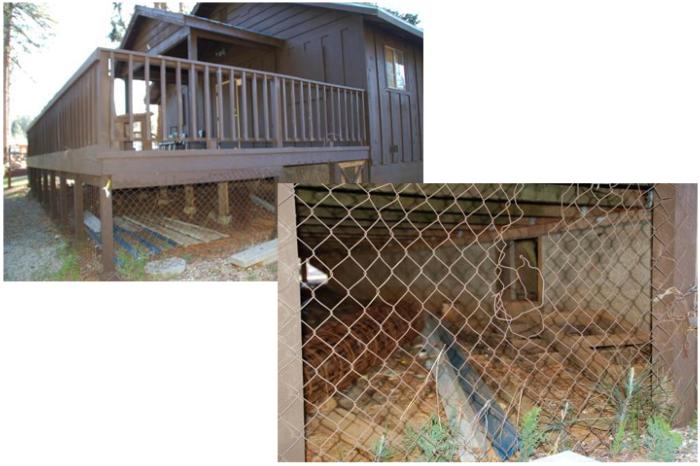
Proximity to the ground: decks set to low to the ground increase difficulty of removing debris (a minus). These decks are also harder to store things under (a plus). The noncombustible rock mulch under the deck on the lower right photo is a good feature.
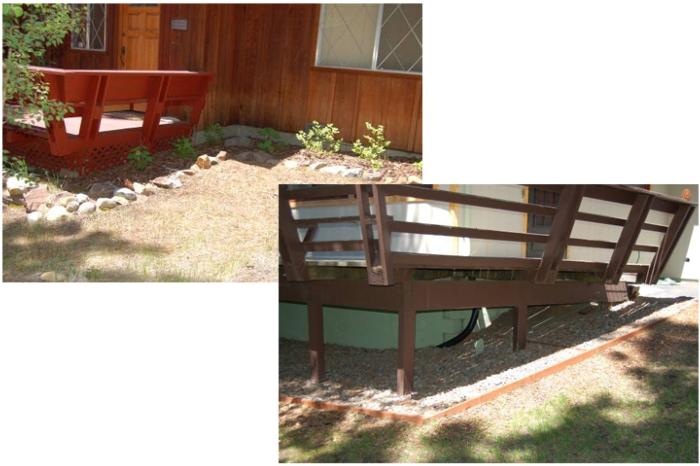
Debris in and storage of construction debris in under deck area makes this deck vulnerable to ignition. If storage space is needed, then enclosing the deck vertically would be advisable. Including a solid surface membrane-deck would provide an added benefit in this case.
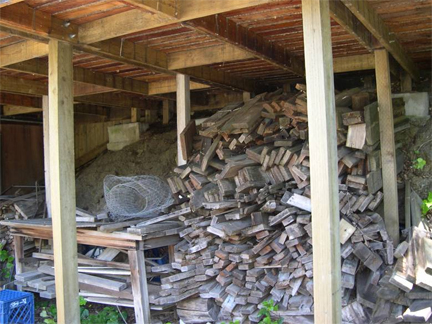
As seen in this slide, tightly installed deck boards will limit the ability of flames to move from the lower to upper surface of a gapped-board deck. However, this would overall be a bad detail given the increased potential to trap water in the joints, thereby increasing the potential for fungal decay.
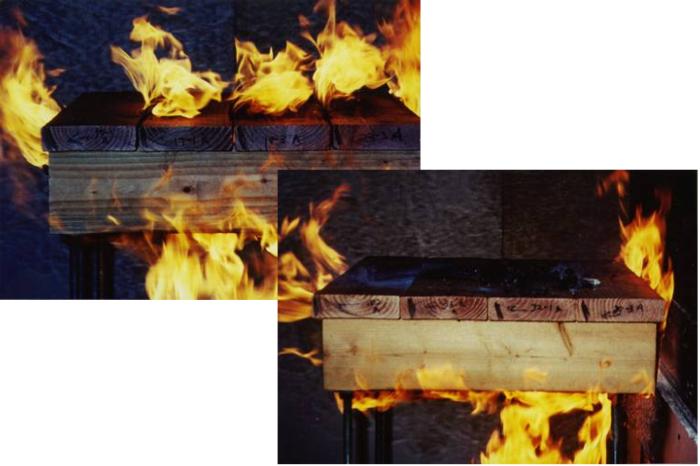
California Code Requirements
Chapter 7A predominately addresses the deck surface (deck boards, rails, treads, etc.), not the underlying structural support members. (i.e., the part of the deck you can walk on). It doesn't require enclosing the deck.
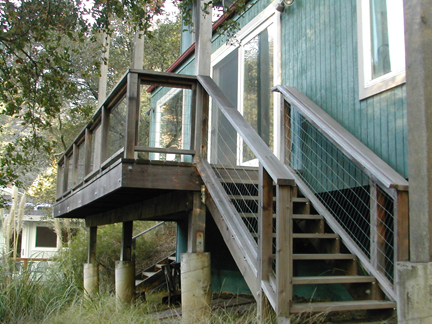
Chapter 7A assumes that you have created an acceptable defensible space around your home or building. This includes the area under the deck. The under-deck area shown in this photograph would not comply with the intended 'defensible space' requirements of the new building code.
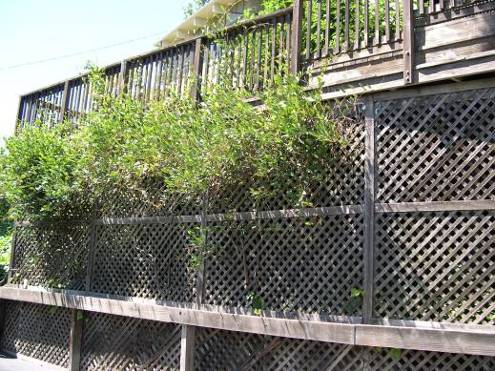
There are three ways decking can comply with the requirements of Chapter 7A. The first is a performance-based method that relies on passing both parts of California Office of the State Fire Marshal standard SFM 12-7A-4 (i.e., Parts A and B). Part A is an under-deck flame impingement exposure. Part B is conducted by placing a large (Class A) burning brand on top of the deck. Decking complying via this option must also be classified as an ignition resistant material.
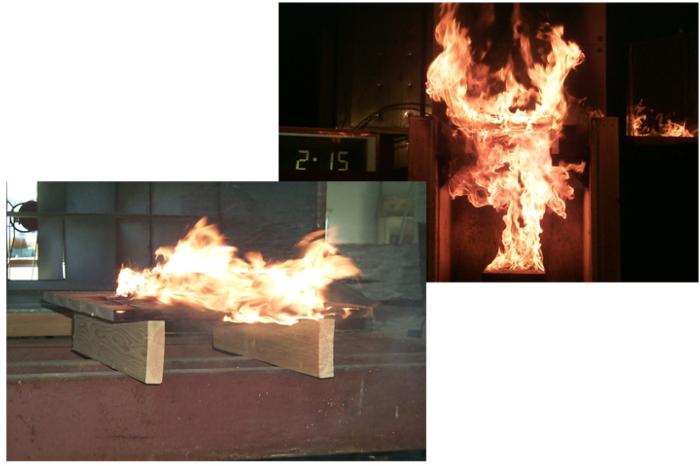
Parts A and B (the first option) have seven conditions of acceptance, as shown below.
Part A, Under deck test:
- Peak heat release rate of less than or equal to 25 kW/ft2.
- Absence of sustained flaming or glowing combustion of any kind at the conclusion of the 40-minute observation period.
- Absence of structural failure of any deck board.
- Absence of falling particles that are still burning when reaching the burner for floor.
Part B, Burning Brand Exposure:
- Absence of sustained flaming or glowing combustion of any kind at the conclusion of the 40-minute observation period.
- Absence of structural failure of any deck board.
- Absence of falling particles that are still burning when reaching the burner of floor.
This slide shows dropping debris (left) and structural failure (right). All seven conditions of acceptance must be met to comply via this option.
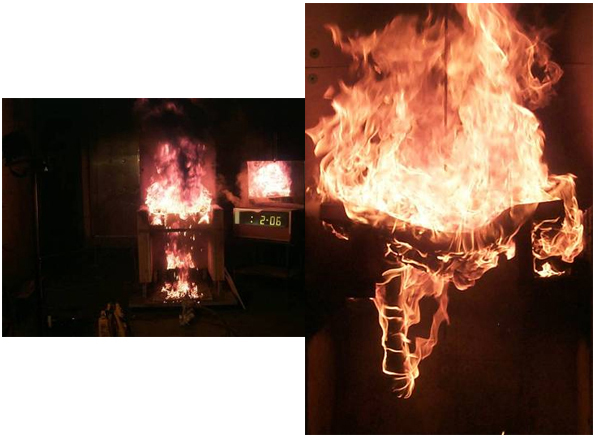
A definition of an ignition resistant material has been adopted and used in Chapter 7A. The definition is based on the test standard UBC 8-1 (ASTM E-84), and utilizes the Steiner Tunnel shown in this photograph. The result of this test is a flame spread rating. The term 'ignition resistant' is given to materials that obtain a flame spread rating of 25 or less when subjected to an extended (30 minute) test. Materials must also be subjected to an accelerated weathering procedure set forth in UBC 23-4 (ASTM D-2898), and meet the same flame spread requirement (< 25) during testing after the exposure. Because the flame spread rating is a relative value, it is unitless. This apparatus is used to determine the flame spread rating of a material. In this case, the test is 10-minutes long.
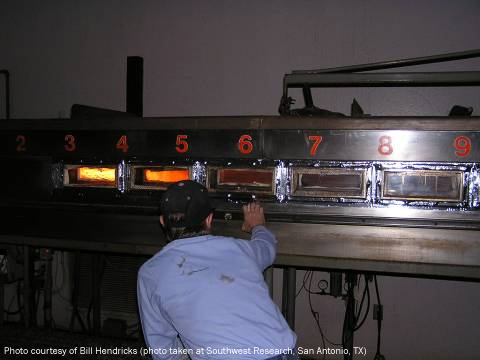
This photograph shows a 12'x12' 'A' brand, 6'x6' 'B' brand, and small 'C' brand. The 'A' and 'B' brands consist of '-inch Douglas-fir sticks that are nailed together in a three-layer sandwich construction. The middle layer is perpendicular to the top and bottom layers.
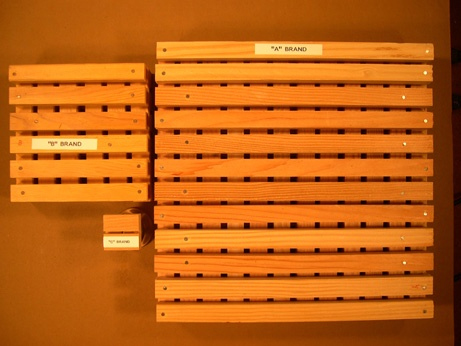
The second method includes a few options, including 1) heavy timber construction (as specified in Section 605.6 in the California Building Code), 2) deck boards that are exterior-rated fire retardant treated lumber (this product meets the definition of an ignition resistant material) or 3) approved noncombustible material (such as metal deck boards or a light weight concrete surface, as shown in this slide). For decking and stair treads, 'heavy timber' means that deck boards are a minimum of 3-inches thick.
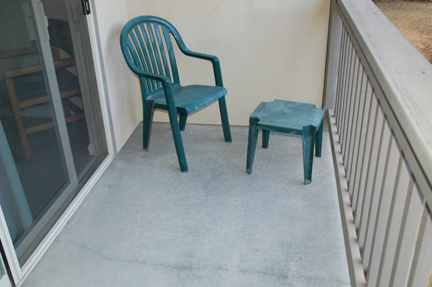
Here is an example of a deck with a 'heavy timber' structural support system. Chapter 7A does not require this kind of construction, although timbers this size are harder to ignite.
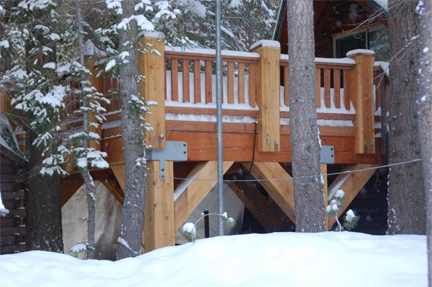
The third option is a variation on the first option, but is less restrictive. The decking only needs to meet the minimum heat release rate requirement of Part A (i.e., the HRR can't exceed 25 kW / ft2 of deck area). The remaining three criteria for Part A don't apply (self-extinguish, dropping flaming debris, and structural failure). Conducting the brand test (Part B) also isn't required.
Products that comply using this option should also provide flame spread information (either Class A, B, or C). If you can't find it, assume Class C. If the flame spread is Class C, then exterior siding within 10-ft of the deck must be either noncombustible or ignition resistant (untreated wood siding, vinyl siding, other combustible siding cannot be used). If the flame spread is either Class A or B, then siding that complies with any of the provisions of Chapter 7A can be used.
Most deck boards comply via this option.
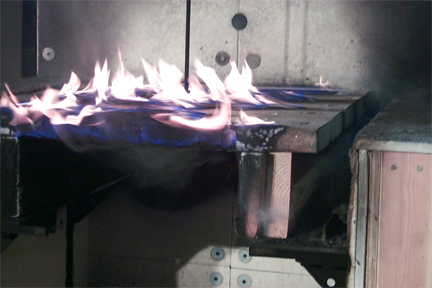
San Diego County has a different requirement for decking. It is more restrictive than the third option and less restrictive than the first option. A summary of the San Diego County requirement is given below.
Part A. Under-deck flame impingement exposure.
- Acceptance criteria:
- HRR < 25 kW/ft2
- Glowing allowed after 40 minutes (no flaming)
- Cannot drop flaming debris
- Cannot break under own load
Part B. Brand test (top of deck) - Use of 'B' brand instead of 'A' brand allowed.
- Acceptance criteria:
- Glowing allowed after 40 minutes (no flaming)
- Cannot drop flaming debris
- Cannot break under own load
Since currently the state doesn't require marking the edge of the deck boards to show compliance and San Diego County does, markings similar to the ones shown in this slide will mean that the product complies in San Diego County.
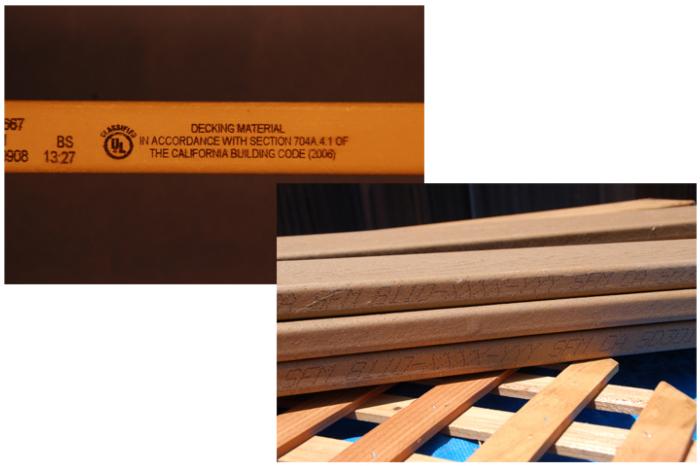
These are examples of various types of wood (or other fiber) plastic composite (WPCs) materials.
Tests conducted at the UCFPL Fire Research Laboratory indicated that boards with channeled construction didn't perform as well when subjected to an under deck flame impingement exposure. Boards with a hollow construction didn't perform as well when exposed to the ('A') brand (on top of deck) test. Engineering and formulation changes that many manufacturers are doing to comply to SFM 12-7A-4 may change this general rule.
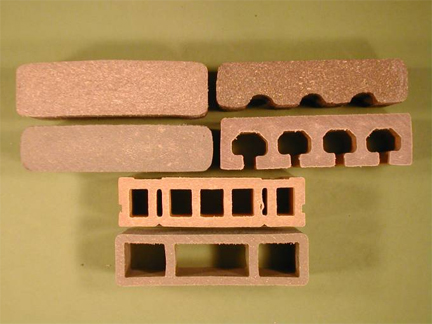
For a current list of deck products that comply to Chapter 7A provisions, go the California State Fire Marshal's wildfire and hazards web page and click on 'New Products Handbook'.
When viewing decking information in the WUI Products Handbook (or other location), be sure to note how the product complied. If by Option 3, then make note of the flame spread rating ' it will be either Class A, B, or C. If the flame spread rating is Class C, then the adjacent siding will have to be either non-combustible (a fiber cement siding product, stucco, etc.), or ignition resistant (such as exterior fire retardant treated wood). Most decking products comply via the third option.
The WUI Products Handbook is published on-line by the Office of the State Fire Marshal as a pdf document. It is updated regularly.
A fee must be paid to OSFM to have a product included in this handbook. Manufacturers are not required to include their compliant products in this, or any, publication. However, this is an easy way to show compliance. Manufacturers wishing to have their product included in this book must have their product tested at an OSFM approved fire laboratory. The test report, prepared by the fire laboratory, must be submitted to OSFM for review and approval.
As part of a fire demonstration, a burning 'B' brand was placed on both of these decks. This photograph was taken approximately 60 minutes after the burning brands were placed on the decks. The decking product on the left does not comply with the provisions of Chapter 7A. The decking product on the right does comply. Since Chapter 7A only applies to new construction (those buildings constructed since January 2008) and not to new decks built on older homes, both of these products are commercially available.
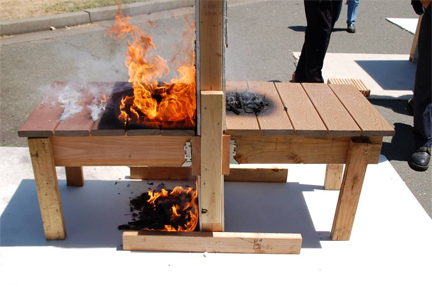
References
DISCLAIMER: Information in this section was compiled as part of the Building in Wildfire Prone Areas project in 2009. This information may or may not be up to date. More recent information may be available from the Insurance Institute for Business and Home Safety, the California Wildland-Urban Interface Code Information, and the CAL FIRE Wildland Hazard/Building Codes site.
- Presentation - Wood Plastic Composite Decking Manufacturing Process: BMWG_Decks_WPC_CourtesyWSU



